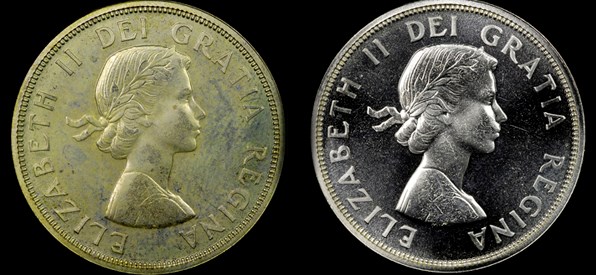NCS Conservation: Residues
Posted on 6/14/2016
Professional conservation by NCS removes harmful surface contaminants, stabilizes a coin’s surfaces and improves its eye appeal. The most common harmful surface contaminants fall under the category of “residue,” and NCS frequently receives submissions of coins that require residue removal.
Residue covers a coin’s surfaces and are not only unattractive, but can also cause permanent damage over time. Coins with active residue are therefore ineligible for NGC grading. NCS specializes in the safe removal of these surface residues. After the residue is carefully removed, the coins can then be graded by NGC.
Most collectors are familiar with “PVC” residue,” which is commonly seen on coins that have been stored for too long in soft plastic “flips” made with Polyvinyl Chloride (PVC), a chemical used to make the plastic more flexible. While hard plastic flips without PVC are available, they are more brittle and more expensive so many collectors and dealers do not use them, which can be a serious mistake. If PVC is not safely removed, it will eventually cause the coin to corrode, an irreversible process that will result in permanent damage. The corrosion will worsen over time until the PVC residue is completely removed.
 |
| PVC Residue |
There are many other types of residue besides PVC residue. These residues often form on the surfaces of coins that have been stored in less-than-ideal locations such as in cigar boxes or coins that have come into contact with different substances. Coins that have been improperly “dipped” in cleaning solutions can often retain traces of that solution.
As with PVC residue, these other residues can cause permanent damage to a coin’s delicate surfaces if left untreated. Fortunately, NCS has developed processes for removing virtually all types of residues and to stabilize a coin’s surfaces. If these residues are caught early enough, NCS conservation can often prevent permanent damage or, at the very least, prevent further damage from occurring.
 |
| Hazing Residue |
It is important to note, however, that residues can sometimes hide other surface problems. In fact, residues may even be applied with that purpose in mind. For example, the residue may hide surface hairlines that are indicative of a prior cleaning. While none of NCS’s processes cause surface hairlines, the removal of residue can sometimes make these hairlines more visible.
Still, it is always advisable to remove active residue from a coin’s surfaces to prevent corrosion or other damage. After the active residue is removed, the coins can then be transferred to NGC, an independent affiliate of NCS, for grading and encapsulation.
Stay Informed
Want news like this delivered to your inbox once a month? Subscribe to the free NGC eNewsletter today!
